Associations between remnant cholesterol levels and mortality in patients with diabetes
Deng Pan,Lin Xu,Li-Xiao Zhang,Da-Zhuo Shi,Ming Guo
Abstract BACKGROUND Dyslipidemia is frequently present in patients with diabetes.The associations of remnant cholesterol and mortality remains unclear in patients with diabetes.AIM To explore the associations of remnant cholesterol with all-cause and cardiovascular mortality in patients with diabetes.METHODS This prospective cohort study included 4740 patients with diabetes who participated in the National Health and Nutrition Examination Survey from 1999 through 2018.Remnant cholesterol was used as the exposure variable,and allcause and cardiovascular mortality were considered outcome events.Outcome data were obtained from the National Death Index,and all participants were followed from the interview date until death or December 31,2019.Multivariate proportional Cox regression models were used to explore the associations between exposure and outcomes,in which remnant cholesterol was modeled as both a categorical and a continuous variable.Restricted cubic splines (RCSs) were calculated to assess the nonlinearity of associations.Subgroup (stratified by sex,age,body mass index,and duration of diabetes) and a series of sensitivity analyses were performed to evaluate the robustness of the associations.RESULTS During a median follow-up duration of 83 months,1370 all-cause deaths and 389 cardiovascular deaths were documented.Patients with remnant cholesterol levels in the third quartile had a reduced risk of all-cause mortality [hazard ratio (HR) 95% confidence interval (CI): 0.66 (0.52-0.85)];however,when remnant cholesterol was modeled as a continuous variable,it was associated with increased risks of all-cause [HR (95%CI): 1.12 (1.02-1.21) per SD] and cardiovascular [HR (95%CI): 1.16 (1.01-1.32),per SD] mortality.The RCS demonstrated nonlinear associations of remnant cholesterol with all-cause and cardiovascular mortality.Subgroup and sensitivity analyses did not reveal significant differences from the above results.CONCLUSION In patients with diabetes,higher remnant cholesterol was associated with increased risks of all-cause and cardiovascular mortality,and diabetes patients with slightly higher remnant cholesterol (0.68-1.04 mmol/L) had a lower risk of all-cause mortality.
Key Words: Diabetes;Remnant cholesterol;Mortality;Cardiovascular;National Health and Nutrition Examination Survey
INTRODUCTION
The prevalence of diabetes is estimated to be 10.9% by 2030[1].The prevalence of cardiovascular disease is two to four times greater in patients with diabetes than in patients without diabetes[2].Dyslipidemia is also frequently present in patients with diabetes as a result of changes in lipoprotein levels triggered by insulin dysfunction and hyperglycemia[3].Among lipid profile,low-density lipoprotein cholesterol (LDL-C) is highly focused in patients with diabetes[4].Therefore,statins are widely used in clinical practice for patients with diabetes,irrespective of the presence of complications[5-7].However,the incidence of major adverse cardiovascular events remains high with the use of current LDL-C lowering strategies[4].Therefore,there is an evidence gap between existing drug therapies and the prevention of adverse events in patients with diabetes,necessitating a focus on lipoproteins other than LDL-C.
Remnant cholesterol,the remaining cholesterol that is not LDL-C or high-density lipoprotein cholesterol (HDL-C),has been found to be associated with a higher risk of peripheral artery disease,ischemic stroke,etc.,and the relationship persisted when controlling for other risk factors,including hypertension and high LDL-C[8-10].Remnant cholesterol and triglycerides are both carried in lipoproteins that are enriched in triglycerides.Moreover,triglyceride-rich lipoproteins can accumulate in the arterial intima,which may further accelerate the progression of atherosclerosis and increase the risk of cardiovascular events[11].Thus,in clinical practice,remnant cholesterol should be considered a potential predictor of atherosclerosis and cardiovascular events for individuals with diabetes,and it is essential to assess the impact of remnant cholesterol on mortality among those patients.
Therefore,in this study,we aimed to explore the associations of remnant cholesterol with all-cause and cardiovascular mortality in patients with diabetes using data from the population-based National Health and Nutrition Examination Survey (NHANES).
MATERlALS AND METHODS
Participants
This study included individuals who participated in the NHANES between 1999 and 2018.We included all adults aged ≥ 18 years with diabetes and complete data on total cholesterol (TC),LDL-C,and HDL-C in mmol/L,resulting in a cohort of 4742 patients.We also excluded patients without a follow-up time (or 0 months) (n=2).Therefore,4740 patients with diabetes were ultimately included in this study (Figure 1).All procedures were performed in accordance with the Declaration of Helsinki.The NHANES study was reviewed and approved by the NCHS Research Ethics Review Board.Written informed consent was obtained from all participants.
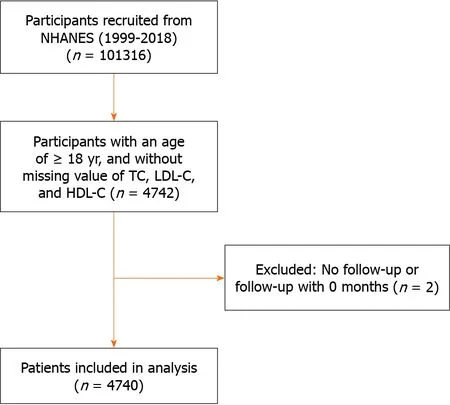
Figure 1 Trial flow chart. TC: Total cholesterol;HDL-C: High-density lipoprotein cholesterol;LDL-C: Low-density lipoprotein cholesterol;NHANES: National Health and Nutrition Examination Survey.
Definition of diabetes
Diabetes status was defined on the basis of the following criteria: Diagnosed with diabetes by a physician,using insulin or oral diabetes medications,hemoglobin A1c≥ 6.5%,plasma fasting glucose ≥ 126 mg/dL (≥ 7.0 mmol/L) (after at least 8 h of fasting) or 2-h blood glucose ≥ 200 mg/dL (≥ 11.1 mmol/L) during an oral glucose tolerance test[12].
Measurement of remnant cholesterol
Blood specimens were collected as part of the NHANES,and lipid profile data,including TC,LDL-C,HDL-C and triglyceride levels,were retrieved from the NHANES website.Using that data,remnant cholesterol was calculated by the following equation: remnant cholesterol (mmol/L)=TC -HDL-C -LDL-C[13].
Ascertainment of mortality
We obtained death data by linking the cohort data with the National Death Index (NDI) through December 31st,2019.Allcause mortality was defined as death for any reason.Cardiovascular mortality was defined by using the International Statistical Classification of Diseases and Related Health Problems,Tenth Revision codes I00 to I78.
Assessment of covariates
Demographic and lifestyle information was collectedviastandard questionnaires during in-person interviews.The demographic covariates included age (continuous),sex (male and female),ethnicity (Mexican American,other Hispanic,non-Hispanic white,non-Hispanic white,and others),poverty-income ratio (< 1,1-3,≥ 3 or unknown),education (less than 9thgrade,9-11thgrade,high school graduate,college,college graduate or above or unknown),body mass index (BMI) (continuous),and survey periods (1999-2000,2001-2002,2003-2004,2005-2006,2007-2008,2009-2010,2011-2012,2013-2014,2015-2016 or 2017-2018).Lifestyle covariates included self-reported smoking status (every day,some days,not at all,or unknown) and self-reported alcohol consumption (nondrinker,1-3 drinks per day,≥ 4 drinks per day or unknown).Clinical covariates included self-reported history of hypertension (yes,no or unknown),hypercholesterolemia (yes,no or unknown),heart failure (yes,no or unknown),coronary heart disease (yes,no or unknown),and cancer (yes,no or unknown).
Statistical analysis
In the present study,all analyses incorporated sample weights,clustering and stratification given the complex sampling design of the NHANES.For normally distributed continuous variables,the data are presented as the mean and SD;for nonnormally distributed continuous variables,the data are presented as the median and interquartile range.Categorical variables are presented as percentages.Differences in age were analyzed using student’sttest.Differences in nonnormally distributed continuous variables were analyzed using the Mann-WhitneyUtest.Differences among categorical variables were analyzed using Pearson’sχ2test.Hazard ratios (HRs) and 95% confidence intervals (CIs) of remnant cholesterol for all-cause mortality and cardiovascular mortality were calculated by Cox hazards models,adjusting for age,sex,ethnicity,BMI,poverty-income ratio,education,smoking status,alcohol consumption,survey period,hypercholesterolemia,hypertension,heart failure,coronary heart disease,and cancer.The group with the lowest quartile of remnant cholesterol was set as the reference group,for which the HR was 1.Additionally,the HR and 95%CI were also calculated for each increase in the SD of remnant cholesterol (treated as a continuous variable).For continuous variables,missing values were imputed by the median value,while for categorical variables,missing data were coded as a separate category “missing”.
Stratified analyses were performed by sex (male,female),age (≥ 60 years,< 60 years),BMI (≥ 30 kg/m2,< 30 kg/m2),duration of diabetes (≥ 10 years,< 10 years),and ethnicity (Mexican American,non-Hispanic white,non-Hispanic black and others).Furthermore,we conducted the following sensitivity analyses: (1) Excluded patients who died within 1 year of follow-up;(2) further adjusted for serum triglyceride levels;(3) adjusted for lipid-lowering and antihypertensive drugs;and (4) adjusted for cardiovascular mortality.We performed analyses accounting for all-cause death as a competing event with the Fine-Gray competing risks model.
We constructed a restricted cubic spline (RCS) model (knots were selected according to the Akaike information criterion;Supplementary Table 1 to examine the associations of remnant cholesterol with all-cause mortality and cardiovascular mortality (25thpercentile as the reference category),adjusting for age,sex,ethnicity,BMI,poverty-income ratio,education,smoking status,alcohol consumption,survey period,hypercholesterolemia,hypertension,heart failure,coronary heart disease,and cancer.A two-sidedP< 0.05 was set as the threshold for statistical significance.All analyses were performed with Stata 17.0 (StataCorp LLC,College Station,Texas).
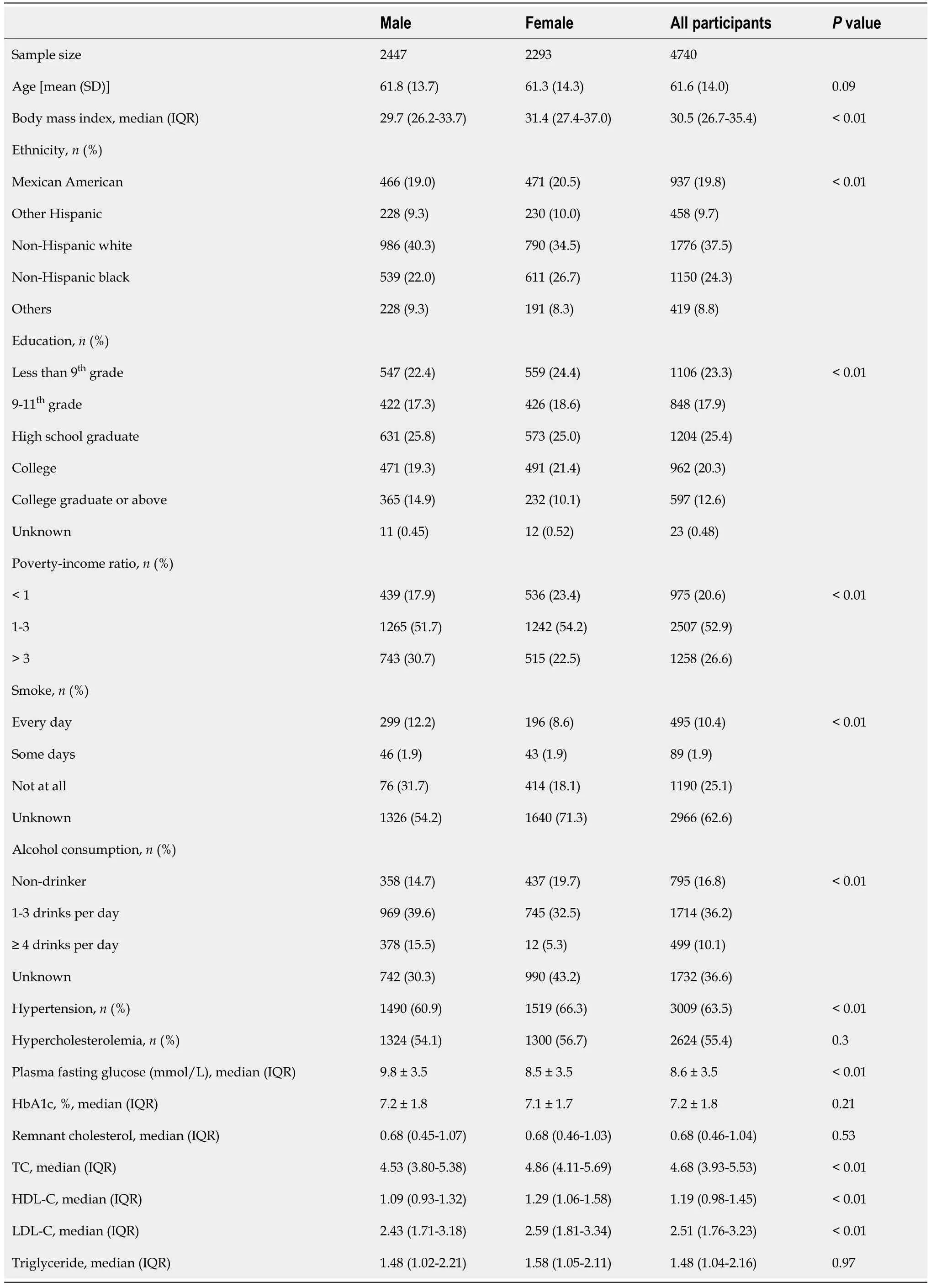
Table 1 Baseline characteristics
RESULTS
Baseline characteristics
A total of 4740 patients with diabetes were included in our analysis.During a median follow-up of 83 months,1370 allcause deaths and 389 cardiovascular deaths were observed.Table 1 shows the baseline characteristics stratified by sex.Among them,2447 patients were male (51.6%).Male patients had a lower BMI and a lower incidence of hypertension.In addition,male patients had a higher fasting serum glucose level.Regarding the lipid profile,we observed higher levels of TC,HDL-C,and LDL-C in female patients with diabetes.However,no significant differences were found in the remnant cholesterol or triglyceride levels between female and male patients.
Remnant cholesterol and all-cause mortality
We observed a nonlinear association between remnant cholesterol levels and all-cause mortality according to the RCS (Figure 2A).When we treated remnant cholesterol as a categorical variable,we found a lower risk in patients in the third quartile of remnant cholesterol than in those in the lowest quartile [Q3: HR (95%CI): 0.66 (0.52-0.85),0.68-1.04 mmol/L].Moreover,we found a greater risk of all-cause mortality when remnant cholesterol was modeled as a continuous variable per SD increase [HR (95%CI): 1.12 (1.02-1.21)] (Table 2,Figure 2B).
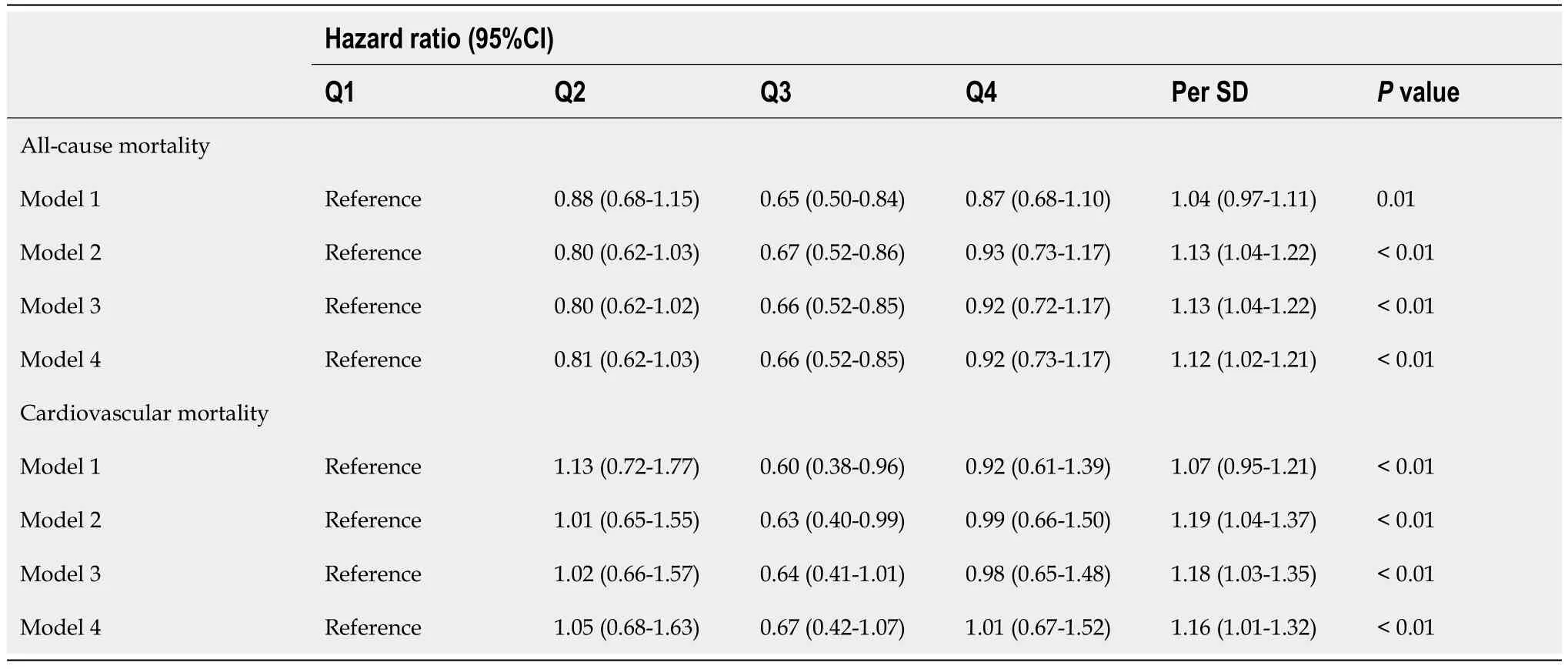
Table 2 Association of remnant cholesterol and all-cause and cardiovascular mortality in patients with diabetes

Figure 2 Association of remnant cholesterol with all-cause mortality. A: Multiple-adjusted restricted cubic splines showing hazard ratios (HR) for the risk of incident all-cause mortality associated with remnant cholesterol.Red solid lines represent HRs,and shaded areas represent 95% confidence intervals.Analysis was adjusted for age,gender,ethnicity,body mass index,poverty-income ratio,education,smoking status,alcohol consumption,survey period,hypercholesterolemia,hypertension,heart failure,coronary heart disease,and cancer;B: Multiple-adjusted HRs for remnant cholesterol by quarters and per standard deviation,in association with the risk of all-cause mortality.
Remnant cholesterol and cardiovascular mortality
Similarly,the RCS also showed a nonlinear association between remnant cholesterol and cardiovascular mortality (Figure 3A).When remnant cholesterol was modeled as a categorical variable,we also observed a U-shaped association,whereas we did not observe a significantly greater or lower risk in the other three quartiles than in the lowest quartile,despite a favorable trend toward a lower risk in the third quartile [Q3: HR (95%CI): 0.67 (0.42-1.07)].In addition,we also found a greater risk per SD increase of remnant cholesterol when it was treated as a continuous variable [HR (95%CI): 1.16 (1.01-1.32)] (Table 2,Figure 3B).

Figure 3 Association of remnant cholesterol with cardiovascular mortality. A: Multiple-adjusted restricted cubic splines showing hazard ratios (HR) for the risk of incident cardiovascular mortality associated with remnant cholesterol.Red solid lines represent HRs,and shaded areas represent 95% confidence intervals.Analysis was adjusted for age,gender,ethnicity,body mass index,poverty-income ratio,education,smoking status,alcohol consumption,survey period,hypercholesterolemia,hypertension,heart failure,coronary heart disease,and cancer;B: Multiple-adjusted HRs for remnant cholesterol by quarters and per standard deviation,in association with the risk of cardiovascular mortality.
Subgroup analyses
We found no interaction between any of the strata and the level of remnant cholesterol (allPinteraction> 0.05) regarding the association with all-cause mortality.The corresponding trends of the different strata were also similar.However,the lower risk associated with the third quartile of remnant cholesterol was not observed in patients with diabetes with a BMI > 30 kg/m2and a duration of diabetes > 10 years or in Mexican Americans [BMI > 30 kg/m2,HR (95%CI): 0.77 (0.52-1.12);duration of diabetes over 10 years,HR (95%CI): 0.69 (0.47-1.02);Mexican American ethnicity,HR (95%CI): 0.55 (0.28-1.05)].Moreover,in non-Hispanic black individuals and individuals of other ethnicities,we observed that there was a trend toward an increase in all-cause mortality risk with elevated remnant cholesterol levels,although no significant increase in risk was associated with any of the individual quartiles of remnant cholesterol.
In addition,there were no significant interactions between any of the strata and remnant cholesterol (allPinteraction> 0.05),indicating no evidence of a differential effect of remnant cholesterol on cardiovascular mortality across the different strata.However,among patients in the third quartile of remnant cholesterol,female patients,patients with a BMI < 30 kg/m2,patients with a duration of diabetes less than 10 years and patients of other ethnicities had a lower risk of cardiovascular mortality [female,HR (95%CI): 0.39 (0.19-0.81);BMI > 30,HR (95%CI): 0.30 (0.15-0.60);duration of diabetes less than 10 years,HR (95%CI): 0.53 (0.29-0.97);other ethnicities,HR (95%CI): 0.12 (0.03-0.45)] (Table 3).
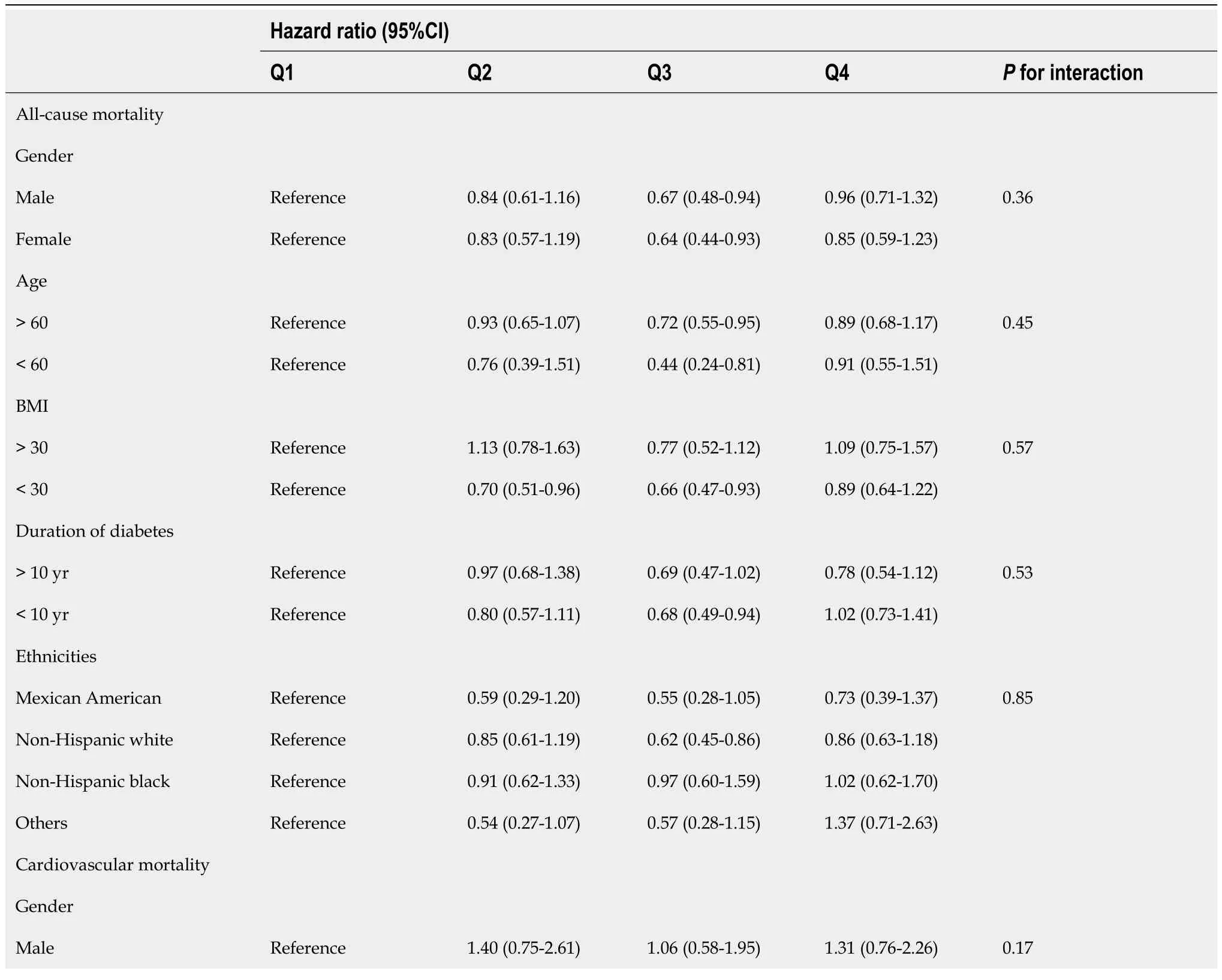
Table 3 Subgroup analyses on remnant cholesterol and all-cause and cardiovascular mortality
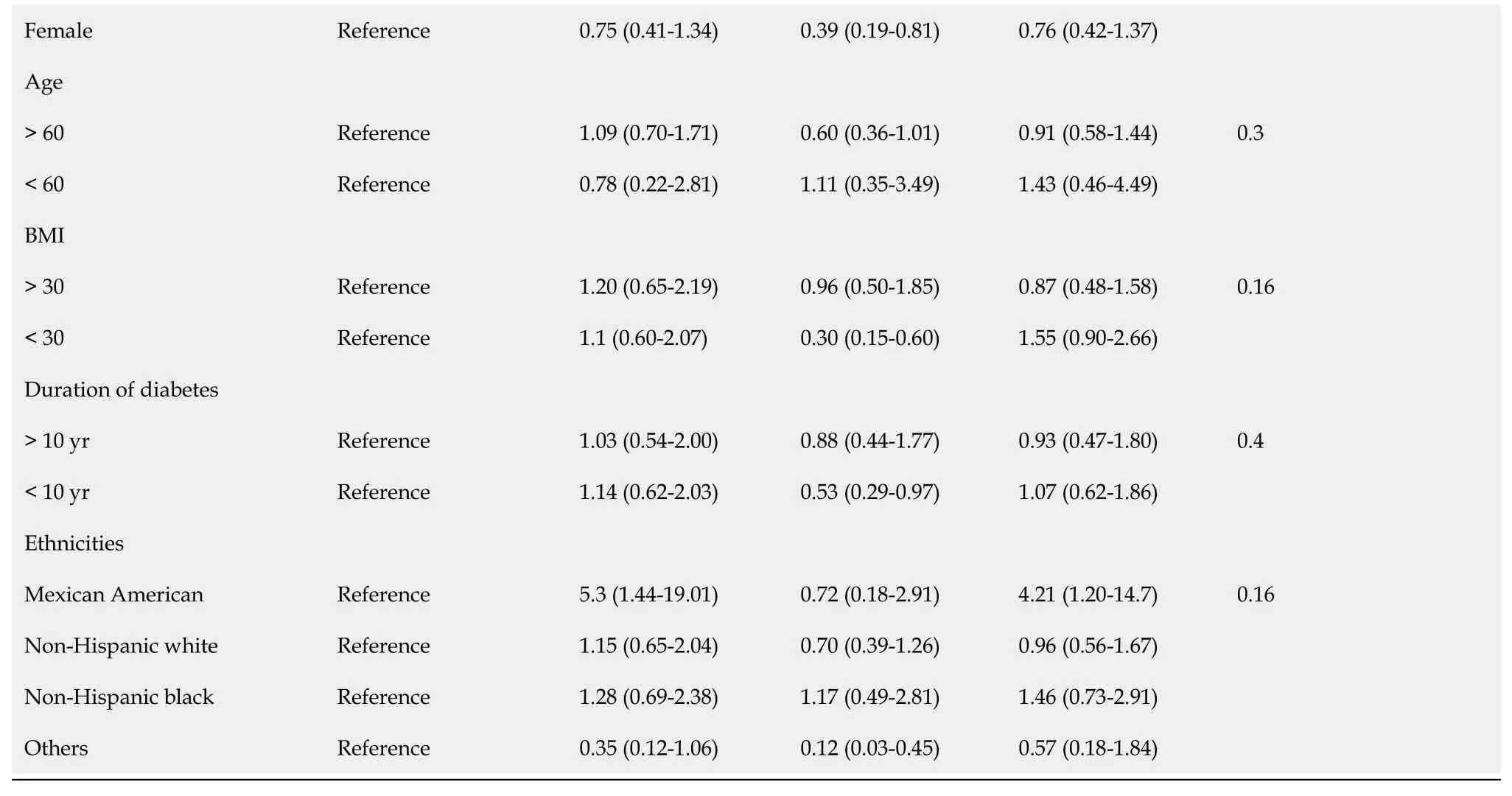
Model 1: No adjustment;Model 2: Adjusted for age,gender,ethnicity,body mass index (BMI),poverty-income ratio,education,survey period;Model 3: Adjusted for age,gender,ethnicity,BMI,poverty-income ratio,education,smoking status,alcohol consumption,survey period;Model 4: Adjusted for age,gender,ethnicity,BMI,poverty-income ratio,education,smoking status,alcohol consumption,survey period,hypercholesterolemia,hypertension,heart failure,coronary heart disease,and cancer.BMI: Body mass index.

Table 5 Sensitivity analysis of remnant cholesterol and all-cause and cardiovascular mortality after further adjusting serum triglycerides

Table 6 Sensitivity analysis of remnant cholesterol and all-cause and cardiovascular mortality after adjusting for lipid-lowering drug and anti-hypertensive drug

Table 7 Sensitivity analysis of remnant cholesterol and cardiovascular mortality after accounting for all-cause death as a competing event by Fine and Gray competing risks model
Sensitivity analyses
The results did not change substantially after the following adjustments were implemented: excluding patients who died within 1 year of follow-up;further adjusting for serum triglycerides;adjusting for lipid-lowering and antihypertensive drugs;and treating all-cause mortality as a competing event for cardiovascular mortality.Our results showed that the associations of remnant cholesterol levels with all-cause and cardiovascular mortality were generally robust (Tables 4-7).
DISCUSSION
To our knowledge,this is the first study on the association between remnant cholesterol and mortality in patients with diabetes.In this study,we analyzed data obtained from a population-based database,NHANES,and explored the association of mortality with the NDI.We found that,in patients with diabetes,patients with a remnant cholesterol level in the third-quartile (0.68-1.04 mmol/L) had a lower risk of all-cause mortality.In addition,a similar trend was observed for cardiovascular mortality,but the association between cardiovascular mortality and a remnant cholesterol level in the third quartile was not statistically significant.
Circulating lipoproteins contain both triglycerides and cholesterol.HDL-C and LDL-C primarily transport cholesterol,while other lipoproteins,such as intermediate-density lipoproteins,chylomicrons,and very low-density lipoproteins (VLDLs),not only transport cholesterol but are also enriched with triglycerides[14].These lipoproteins vary in size,and particles such as VLDLs and chylomicrons may not be able to enter the arterial wall.However,their remnants are able to penetrate into the arterial wall and become trapped.Subsequently,these proteins interact with apoE and apoC-III before being taken up by macrophages[15].Finally,the accumulation of these remnants accelerates the progression of atherosclerosis[16,17].A Danish study recruited patients with ischemic heart disease and revealed that those with elevated remnant cholesterol (> 1 mmol/L) had a greater risk of all-cause mortality[18].In addition to its significant role in exacerbating the progression of atherosclerosis,remnant cholesterol is related to impaired vasodilation and an aggravated inflammatory response[19,20].Genetic studies have also reported that elevated remnant cholesterol is a causal risk factor for coronary artery disease[21,22].Another study demonstrated that remnant cholesterol is associated with hepatic steatosis[23].Moreover,a different study based on NHANES data indicated that patients with hepatic steatosis had anincreased systemic immune-inflammation index,which is also associated with an increased risk of all-cause mortality[24,25].Additionally,the systemic immune-inflammation index was shown to be associated with a higher risk of abdominal aortic calcification,which is also a strong predictor of cardiovascular mortality[26].In line with the findings of previous studies,our findings similarly demonstrated a greater risk of both all-cause and cardiovascular mortality when analyzing their association with remnant cholesterol levels as a continuous variable.
In patients with diabetes,remnant cholesterol has recently received much attention because of its association with clinical events.For example,in a Chinese cohort study that included 516 individuals diagnosed with type 2 diabetes mellitus,the results indicated that patients with peripheral artery disease exhibited elevated levels of remnant cholesterol,and patients with higher remnant cholesterol (> 0.64 mmol/L) had an increased risk of developing peripheral artery disease[27].Another study including 4569 white Danish patients with diabetes reported that patients with elevated remnant cholesterol had increased risks of peripheral artery disease,myocardial infarction,ischemic stroke and any atherosclerotic cardiovascular disease[28].However,despite the established understanding that a higher level of remnant cholesterol increases the risk of clinical events,which was supported in the present study,the exact level of remnant cholesterol associated with mortality in patients with diabetes is still uncertain due to limited study data.A Chinese study indicated that patients with diabetes and diabetic nephropathy who had elevated remnant cholesterol (over 30 mg/dL,0.77 mmol/L) had a greater risk of cardiovascular mortality than did those with lower remnant cholesterol levels[29].Caoetal[30] reported that individuals with coronary artery disease and diabetes or prediabetes who had elevated remnant cholesterol (> 0.54 mmol/L) had a greater risk of major adverse cardiovascular events.Nonetheless,these studies primarily focused on Asian individuals and were limited by relatively shorter follow-up periods.Studies have demonstrated diverse metabolic statuses in different ethnicities[31,32].The present study included patients from the NHANES,a nationwide population-based database with diverse ethnicities.Furthermore,this study had a longer followup duration,allowing us to draw more reliable conclusions.
Our research included a highly representative population and used a long follow-up period.Furthermore,weights were used in our statistical analysis,leading to credible conclusions.However,several limitations should also be noted.First,mortality was ascertainedviathe NDI,potentially leading to misclassification.However,a prior validation study confirmed the accuracy of the matching method[33].Second,the estimated remnant cholesterol aligned closely with the measured remnant cholesterol levels at lower LDL-C levels,but a noticeable difference was evident at higher LDL-C levels.However,the measured remnant cholesterol level is not currently provided by the NHANES,which may warrant further investigation.Third,the incidence of cardiovascular mortality was relatively low,which might result in a broad CI and hinder us from examining the true association between remnant cholesterol and cardiovascular mortality.Fourth,dietary inflammation plays an important role in hepatic steatosis and lipid metabolism,especially in patients with diabetes[34,35].However,the provision of dietary data was not consistent throughout the entire study period,which limited our ability to arrive at a more comprehensive conclusion.
CONCLUSlON
In patients with diabetes,higher remnant cholesterol increased the risk of all-cause and cardiovascular mortality,and diabetes patients with slightly higher remnant cholesterol (0.68-1.04 mmol/L) had a lower risk of all-cause mortality.
ARTlCLE HlGHLlGHTS
Research background
Additional research is needed to explore the underlying mechanism of the relationship between remnant cholesterol and mortality.
Research motivation
The optimal remnant cholesterol level for decreasing the risk of all-cause mortality in patients with diabetes was 0.68-1.04 mmol/L.A high level of remnant cholesterol was associated with an increased risk of all-cause and cardiovascular mortality.
Research objectives
The associations of remnant cholesterol with all-cause and cardiovascular mortality were U-shaped.Patients with diabetes in the third quartile of remnant cholesterol (0.68-1.04 mmol/L) had a lower risk of all-cause mortality,and a per standard deviation increase in remnant cholesterol was associated with a higher risk of all-cause and cardiovascular mortality.
Research methods
This cohort study included 4740 patients with diabetes who participated in the National Health and Nutrition Examination Survey from 1999 through 2018.We divided remnant cholesterol into four quartiles,and all participants were followed from the interview date until death or December 31,2019.Multivariate proportional Cox regression models were used to calculate hazard ratios and 95% confidence intervals.Additionally,a series of subgroup and sensitivity analyses were performed.
Research results
The aim of the present study was to explore the associations of remnant cholesterol with all-cause and cardiovascular mortality in patients with diabetes.
Research conclusions
In current clinical practice,the lipid profile is different between patients with diabetes and nondiabetic patients.However,evidence for the association between remnant cholesterol levels and mortality is lacking.
Research perspectives
Remnant cholesterol is associated with mortality,but the role of remnant cholesterol in patients with diabetes is unclear.
ACKNOWLEDGEMENTS
We would like to appreciate the support by participants involved in the National Health and Nutrition Examination Survey study.
FOOTNOTES
Co-first authors:Deng Pan and Lin Xu.
Co-corresponding authors:Da-Zhuo Shi and Ming Guo.
Author contributions:Pan D and Xu L performed statistical analysis;Xu L and Zhang LX retrieved raw data from NHANES;Pan D,Shi DZ designed the study.Pan D,Shi DZ and Guo M wrote the manuscript;Xu L and Guo M acquired the fundings supporting the article.The reasons for designating Xu L and Pan D as co-first authors are as follows: First,the research was performed as a collaborative effort,the effort to retrieve raw data is necessary,and statistical analysis is also essential to finish the article.Second,the two authors cooperated together,Pan D designed the study and Xu L made effort to acquire data.Additionally,Pan D wrote the draft,and two authors managed post-submission matters.We think it is necessary for the article and the two authors contributed with equal importance.Shi DZ and Guo M were co-corresponding authors,the reasons were as follows.Shi DZ inspired the study design and checked the data from NHANES,and confirm the accuracy of the data.Moreover,Shi DZ wrote the draft for the manuscript.Guo M also wrote the draft,and responsible for the revision of the article.In addition,Guo M acquired the fundings and also maintained the raw data.Guo M and Shi DZ are responsible for the data.Hence,we thought Guo M and Shi DZ as co-corresponding authors.
Supported byProject of National Natural Science Foundation of China,No.82274345 and No.82 104907;and Fundamental Research Funds for the Central public welfare research institutes Grant,No.ZZ13-YQ-016 and No.ZZ13-YQ-016-C1.
lnstitutional review board statement:The NHANES study was reviewed and approved by the NCHS Research Ethics Review Board.
Clinical trial registration statement:This is a cohort study based on National Health and Nutrition Examination Survey (NHANES) without any intervention and does not require a registration.
lnformed consent statement:This is a cohort study based on National Health and Nutrition Examination Survey (NHANES) without any intervention.All participants have provided the consent forms according to NHANES official.
Conflict-of-interest statement:The authors declare they have no conflict of interest.
Data sharing statement:The datasets generated and/or analyzed during the current study are available from https://www.cdc.gov/nchs/nhanes/.
CONSORT 2010 statement:The authors have read the CONSORT 2010 Statement,and the manuscript was prepared and revised according to the CONSORT 2010 Statement.
Open-Access:This article is an open-access article that was selected by an in-house editor and fully peer-reviewed by external reviewers.It is distributed in accordance with the Creative Commons Attribution NonCommercial (CC BY-NC 4.0) license,which permits others to distribute,remix,adapt,build upon this work non-commercially,and license their derivative works on different terms,provided the original work is properly cited and the use is non-commercial.See: https://creativecommons.org/Licenses/by-nc/4.0/
Country/Territory of origin:China
ORClD number:Ming Guo 0000-0003-3728-9170.
S-Editor:Qu XL
L-Editor:A
P-Editor:Yuan YY
 World Journal of Diabetes2024年4期
World Journal of Diabetes2024年4期
- World Journal of Diabetes的其它文章
- Nε-carboxymethyl-lysine and inflammatory cytokines,markers and mediators of coronary artery disease progression in diabetes
- Non-pharmacological interventions for diabetic peripheral neuropathy: Are we winning the battle?
- Application and management of continuous glucose monitoring in diabetic kidney disease
- Role of renin-angiotensin system/angiotensin converting enzyme-2 mechanism and enhanced COVlD-19 susceptibility in type 2 diabetes mellitus
- Are treatment options used for adult-onset type 2 diabetes mellitus (equally) available and effective for children and adolescents?
- Prevalence and risk factors of wound complications after transtibial amputation in patients with diabetic foot
